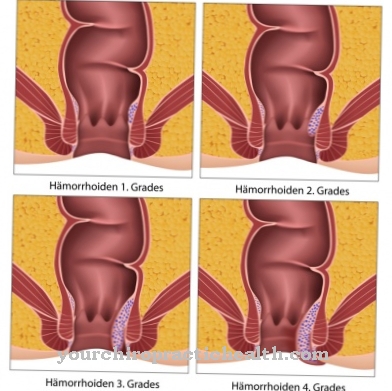Of the anaphylactic shock or allergic shock is a condition that is life threatening and and imperatively requires rapid detection and treatment.
What is anaphylactic shock?
.jpg)
In connection with different allergic reactions, which can occur due to different causes, the anaphylactic shock represents one of the strongest health impairments. Since the anaphylactic shock shows the symptoms of a severe allergy, the designations allergic shock or allergy shock are also appropriate.
Anaphylactic shock shows the typical signs of a classic shock state, which usually occurs acutely and very quickly after the trigger has taken effect. If not recognized and if the course is untreated, anaphylactic shock can lead to a loss of function of the entire cardiovascular system. This condition is considered life-threatening in anaphylactic shock.
The diagnosis of anaphylactic shock can be made relatively quickly with a high degree of certainty. This is possible because very characteristic health impairments occur.
causes
The causes that lead to the development of an anaphylactic shock are mostly due to external triggers that are also characteristic of normal allergies. In addition to wasp or bee stings (insect venom allergy), anaphylactic shock also occurs when there is an intolerance to substances in medication.
This is often seen with penicillin. In addition, use of different contrast media for X-ray diagnostic procedures via the injection route also leads to an anaphylactic shock. As a rule, allergy sufferers are extremely sensitive to various components in food. These can come from fruit or nuts. (see food allergy (food allergy))
In addition, allergens from animals such as animal hair or the excrement of mites (see house dust allergy) are considered to be the causal triggers of anaphylactic shock. In most cases, anaphylactic shock builds up in those patients who have already been diagnosed with type 1 allergies.
Symptoms, ailments & signs
Depending on the severity, anaphylactic shock manifests itself through a number of symptoms. A severity one allergic shock is associated with mild general reactions such as dizziness, headache and nausea. In addition, skin reactions such as itching, hives and redness can occur.
Severity level two causes similar symptoms, but there are other signs such as an accelerated heartbeat, drop in blood pressure and slight shortness of breath. The nausea develops into serious gastrointestinal complaints - vomiting, diarrhea and other sequelae occur. Third-degree anaphylactic shock is characterized by spasms of the airway muscles and a shock response.
In individual cases, larynx swelling with shortness of breath occurs. Severity IV leads to respiratory and cardiovascular arrest. The affected person usually becomes unconscious or has severe convulsions, which clearly indicate a severe course. Depending on the type and severity of the allergy, further symptoms and complaints can occur.
A pollen allergy is usually associated with respiratory problems and runny nose, while a food allergy can manifest itself through serious gastrointestinal complaints and fever. Anaphylactic shock can be recognized by the fact that it occurs shortly after contact with an allergen and causes several symptoms within a few minutes.
course
The course of anaphylactic shock is characterized in an acute form, which shows that the symptoms occur in two stages. In anaphylactic shock, these are called the initial phase and the systemic reaction. In the initial phase, those affected initially suffer from malaise, nausea and slight diarrhea as well as pain in the intestinal area.
Localized changes in the skin occur in anaphylactic shock and breathing difficulties appear. In anaphylactic shock, these resemble a mild asthma attack. In the further course of the anaphylactic shock, increasing itching, severe skin redness on the face, inflammatory processes on the skin with intense redness and hives can be observed. Due to the narrowing of the airways by their swelling, anaphylactic shock continues to lead to increased shortness of breath.
People usually vomit and show a marked decrease in blood pressure. The pulse (low pulse) quickly flattens out if left untreated, the patient loses consciousness and the cardiovascular system comes to a standstill.
The latter symptoms are characteristic of a typical state of shock and, in anaphylactic shock, are due to the fact that the blood vessels expand enormously.
Complications
In anaphylactic shock (allergic shock), there is initially a sharp drop in blood pressure and an increase in heart rate. Due to the drop in blood pressure, important organs are no longer adequately supplied with blood, which can subsequently fail, including the kidneys and lungs in particular.
In harmless cases of anaphylaxis, there is only reddening of the skin and mild itching. However, these symptoms quickly disappear if the corresponding allergen is avoided and heal without complications. Nausea, vomiting and diarrhea can also occur. If you use an allergy drug, these harmless symptoms will quickly subside without any consequences.
In addition, in the more severe cases there is severe swelling of the muscles in the neck and bronchi, which leads to swallowing difficulties and difficult breathing, which can lead to shortness of breath and even suffocation. In the context of Quincke's edema, in which the deeper layers of the skin also swell, the symptoms are even worse. In addition to the neck and face, the hands, feet and genitals are usually painfully swollen with Quincke's edema.
Anaphylactic shock can cause the person to lose consciousness and stop breathing. An emergency doctor should therefore be called in immediately, as this, if left untreated, can lead to cardiac arrest and thus death of the patient.
When should you go to the doctor?
Anaphylactic shock often affects people with allergies. It is potentially fatal and therefore an extreme emergency situation. An emergency doctor or an ambulance must be alerted immediately. An allergic shock can have different degrees of severity - but it is never to be trifled with.
It may be known that the person is allergic. People suffering from allergies often inform their fellow human beings that they are allergic to certain things. In this case there is often a four-part emergency set in the house. If the person can still be contacted, those present can ask them where they are kept. Otherwise, calling an emergency doctor is the first step. A paramedic or emergency doctor may be on site at public events. Alerting this would also be a suitable measure. It is important to act quickly. Suspicion of anaphylactic shock must be expressed.
The first aid measures in the event of an anaphylactic shock must be carried out depending on the condition of the person concerned. Breathing should be facilitated if you are short of breath. If you are unconscious, you need to lie on your side in a stable position. Circulatory problems require the legs to be raised. If necessary, resuscitation measures such as chest compressions and ventilation should be initiated. The doctor called in will decide on further measures after his arrival. With timely administration of antihistamine, cortisone and / or histamine, the allergy sufferer usually gets back on their feet.
Doctors & therapists in your area
Treatment & Therapy
Treatment for anaphylactic shock depends on the severity of the individual symptoms and the patient's condition. In addition to rapid emergency medical treatment, further treatment is also required for anaphylactic shock.
In addition to the practiced first aid measures that are used in the event of a shock, doctors also use special medication for anaphylactic shock. These are supposed to stop the allergic reaction and stabilize the cardiovascular system again. In addition to adrenaline and glucocorticoids, the drugs used also include antihistamines and beta-2 sympathomimethics.
The latter group of drugs influences the conduction of stimuli in the heart and, like all other substances in anaphylactic shock, is infused into the organism. The other drugs prevent the airways from narrowing and clear the bronchi again.
Outlook & forecast
As a rule, the further course of this complaint strongly depends on the cause of the shock, so that a general prediction is not possible in most cases. However, this is a life-threatening condition that must definitely be treated by a doctor.
Those affected usually suffer from circulatory problems and also from circulatory shock. There is also vomiting and nausea. Patients also experience difficulty breathing and have rapid heart rates, which can lead to a loss of consciousness. Not infrequently, this shock also leads to anxiety and a panic attack. Redness and itching also appear on the skin or directly at the injection site and can further reduce the quality of life. In the worst case, the affected person suffers a complete cardiac arrest and dies in the process.
As a rule, anaphylactic shock can be treated relatively well with the help of medication and first aid measures. There are no particular complaints or complications. If the treatment is successful and rapid, the life expectancy of the patient is not affected.
prevention
To counteract anaphylactic shock prophylactically, it makes sense to pay attention to the known triggering causes and to avoid them. However, if these still get into the organism, an emergency kit or a special emergency preparation can be helpful to prevent the development of an anaphylactic shock. This can be represented either by a drug containing glucocorticoids or an antihistamine in anaphylactic shock.
Aftercare
In the event of an anaphylactic shock, follow-up care consists of further monitoring of the person concerned and taking preventive measures. If someone is taken to hospital with anaphylactic shock, first aid is provided. The patient is then medically monitored for a certain period of time - for example to rule out organ damage or to check the circulatory functions.
If necessary, further medical measures are then taken. These range from the administration of drugs to the replacement of organ functions with machines, which depends on the severity of the anaphylactic shock. The monitoring time in the intensive care unit is usually at least 24 hours.
If it is the first allergic shock without a known allergen, an attempt is usually made to locate the allergen. An anaphylaxis pass can then be issued. In addition, those affected are advised to urgently contact a doctor who can provide further preventive measures for the possible allergy.
There is no medical follow-up in the narrower sense of the word for an allergic shock. Rather, prophylactic measures (such as avoiding the allergen) must be taken.In addition, after the first anaphylactic shock at the latest, the person affected should have an emergency kit with them so that measures can be taken quickly in the event of a further shock.
You can do that yourself
Since vital organs are affected in anaphylactic shock, a doctor should be consulted immediately. If allergic shock occurs as a serious form of allergic reaction, it is important to remain calm and carry out first aid measures.
Since anaphylactic shock is associated with circulatory problems, these should be minimized by elevating the legs. This can promote blood flow to the brain. The use of the stable side position is also recommended, as this keeps the airways open. In addition to keeping calm and avoiding panic actions, it is important to recognize the triggering allergen. If the allergen is known, further intake should be prevented immediately.
If the allergic reaction has occurred through an insect bite, the sting of the insect can be removed by careful scratching so that further toxins can no longer get into the human system. Anyone who has antiallergic drugs in their immediate vicinity should take them immediately.
If those affected know about the triggering allergen in advance and suspect an allergic shock reaction, they should always carry the antiallergic medication with them if possible. In this way, those affected are well prepared for an emergency, can create a little security and minimize their fears of a dangerous shock reaction.

.jpg)






















.jpg)



